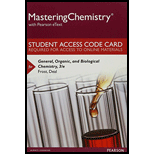
Concept explainers
a.
To determine:
The molecular formula of the given compound.
Introduction:
The molecular formula of a compound is defined as the formula that is used to show the total number of atoms of individual elements that are present in a given compound. This formula does not show the arrangement of the atoms in a molecule.
b.
To determine:
The molecular formula of the given compound.
Introduction:
The molecular formula of a compound is defined as the formula that is used to show the total number of atoms of individual elements that are present in a given compound. This formula does not show the arrangement of the atoms in a molecule.
c.
To determine:
The molecular formula of the given compound.
Introduction:
The molecular formula of a compound is defined as the formula that is used to show the total number of atoms of individual elements that are present in a given compound. This formula does not show the arrangement of the atoms in a molecule.
Want to see the full answer?
Check out a sample textbook solution
Chapter 4 Solutions
Mastering Chemistry with Pearson eText -- Standalone Access Card -- for General, Organic, and Biological Chemistry (3rd Edition)
- Classify the organic compounds by the class of their functional group.arrow_forwardIllustrate with the use of concept map the difference between the classification of organic compounds. Use the main idea such as the classification of organic compounds and its supporting details.arrow_forwardCharacterize the features of organic compounds?arrow_forward
- A. What is the abbreviated structural and skeletal formulas for the linear hydrocarbon with the molecular formula C4H10? B. During a chemical reaction, one bromine atom replaces one of the hydrogen atoms in the compound above. Draw the skeletal formula for all the possible isomers that could be formed as a result of this replacement.arrow_forward1a. . Isomers are responsible for the diversity of organic compounds. true or false? b. Positional isomers are molecules with different arrangements of the carbon skeleton but with the same chemical formula. true or false? c.)arrow_forwardWhich statement about organic compounds is false? In organic compounds, carbon typically forms exactly 5 bonds. Organic compounds are primarily composed of carbon atoms. Organic compounds are usually non-polar. Organic compounds are usually insoluble in water. Organic compounds usually have low melting points.arrow_forward
- Which chemical formulas represent organic compounds and which represent inorganic compounds: (a) H 2SO 4; (b) Br 2; (c) C 5H 12?arrow_forward1. Give two organic compounds. The first compound must be a synthetic or man-made organic compound and the second compound must be a natural product or organic compound from natural sources (medicinal plant, coral, animal such as snail or microorganism such as bacteria or fungi). Compounds must have equal to or more than twenty carbon atoms. 2. Your chosen organic compound must have application in the management of human health or veterinary medicine. (for example for the treatment of pain or bacterial infection in human and animal).arrow_forwardWhat is the molecular formula for a Hydroxyl group? What is the molecular formula for an Amino Group? What is the molecular formula for a Phosphate group? What is the molecular formula for a methyl group? What is the molecular formula for a carbonyl group? What is the molecular formula for a carboxyl group? Which of the molecular groups are considered organic?arrow_forward
 Chemistry & Chemical ReactivityChemistryISBN:9781337399074Author:John C. Kotz, Paul M. Treichel, John Townsend, David TreichelPublisher:Cengage Learning
Chemistry & Chemical ReactivityChemistryISBN:9781337399074Author:John C. Kotz, Paul M. Treichel, John Townsend, David TreichelPublisher:Cengage Learning Chemistry & Chemical ReactivityChemistryISBN:9781133949640Author:John C. Kotz, Paul M. Treichel, John Townsend, David TreichelPublisher:Cengage Learning
Chemistry & Chemical ReactivityChemistryISBN:9781133949640Author:John C. Kotz, Paul M. Treichel, John Townsend, David TreichelPublisher:Cengage Learning Chemistry for Today: General, Organic, and Bioche...ChemistryISBN:9781305960060Author:Spencer L. Seager, Michael R. Slabaugh, Maren S. HansenPublisher:Cengage LearningChemistry: Matter and ChangeChemistryISBN:9780078746376Author:Dinah Zike, Laurel Dingrando, Nicholas Hainen, Cheryl WistromPublisher:Glencoe/McGraw-Hill School Pub Co
Chemistry for Today: General, Organic, and Bioche...ChemistryISBN:9781305960060Author:Spencer L. Seager, Michael R. Slabaugh, Maren S. HansenPublisher:Cengage LearningChemistry: Matter and ChangeChemistryISBN:9780078746376Author:Dinah Zike, Laurel Dingrando, Nicholas Hainen, Cheryl WistromPublisher:Glencoe/McGraw-Hill School Pub Co Introductory Chemistry: A FoundationChemistryISBN:9781337399425Author:Steven S. Zumdahl, Donald J. DeCostePublisher:Cengage Learning
Introductory Chemistry: A FoundationChemistryISBN:9781337399425Author:Steven S. Zumdahl, Donald J. DeCostePublisher:Cengage Learning





